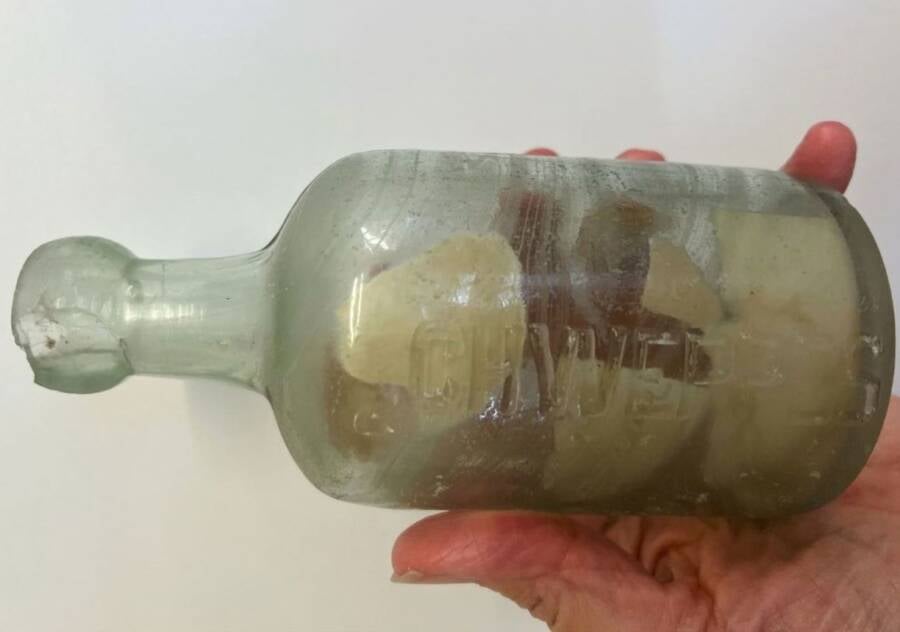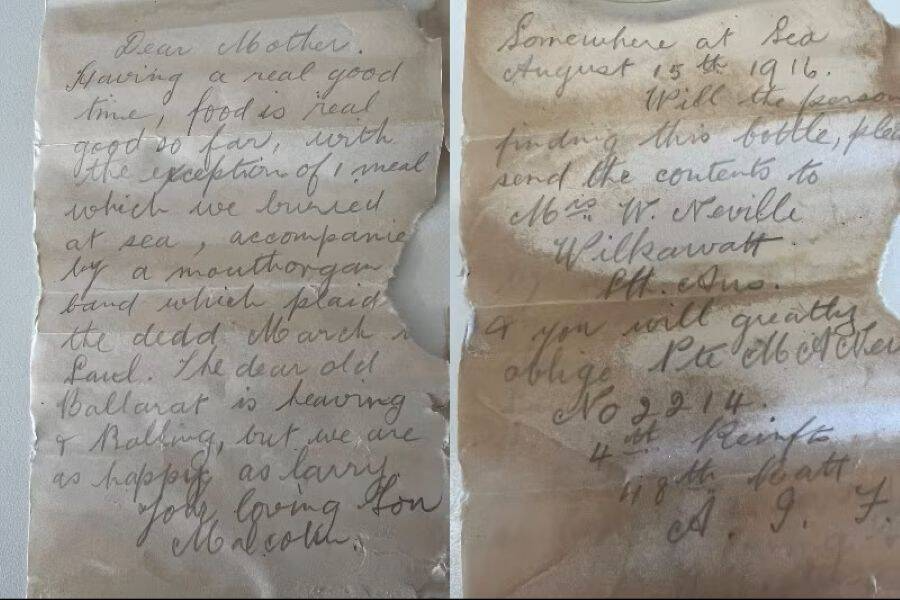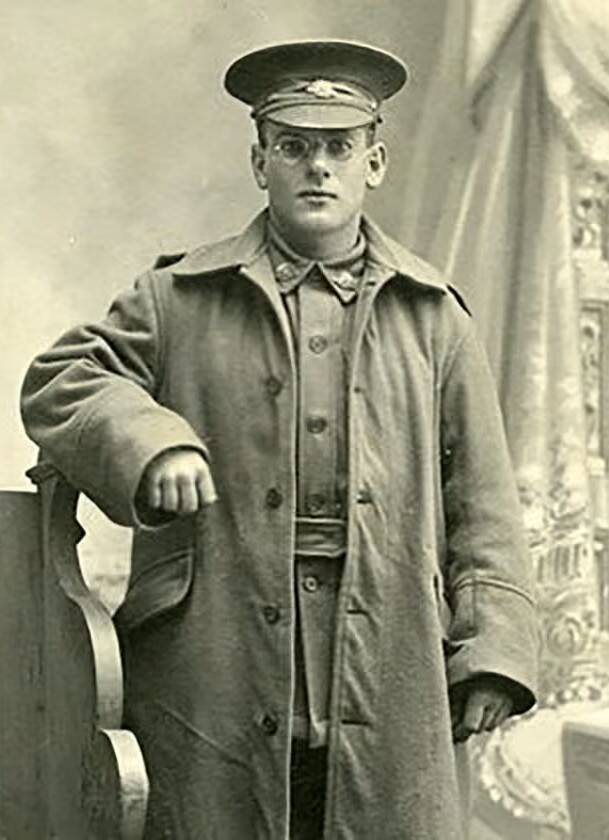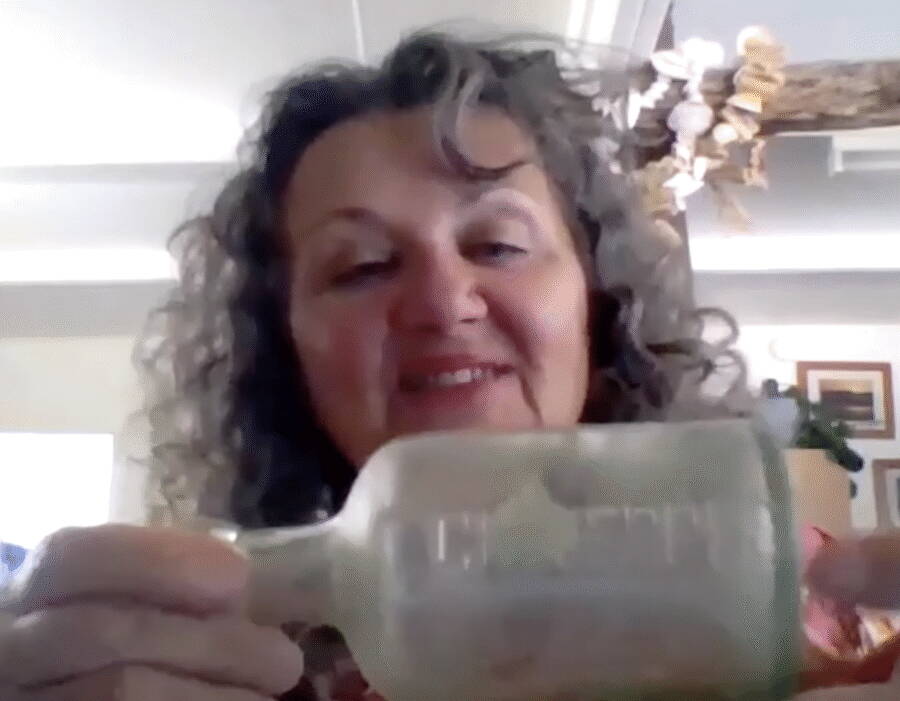On August 15, 1916, Private Malcolm Alexander Neville penned this two-page note to his mother, reporting on his voyage toward Europe and asking whoever found the bottle to deliver it to her.

Debra Brown/Australian Broadcasting CorporationOn October 9, Debra Brown was walking along Wharton Beach near Esperance, Australia when she saw this glass Schweppes bottle lying in the sand.
A bottle containing messages from World War I soldiers headed to the Western Front were recently found on an Australian beach, more than a century after they were written.
The bottle contained two 109-year-old messages from soldiers that had been placed in a Schweppes bottle and tossed overboard while they were on their way to Europe. They were found on October 9 on Australia’s Wharton Beach by Debra Brown and her family while they were picking up trash along the beach.
They took the bottle home and read the messages inside. Since reading the notes, the families of both of the soldiers have been contacted about this extraordinary discovery.
Two Messages In A Bottle From Australian Soldiers Headed Off To World War I

Debra Brown/Australian Broadcasting CorporationMalcolm Neville’s letter to his mother.
Inside the bottle, Brown found messages from Privates Malcolm Neville and William Harley, both dated August 15, 1916, according to the Associated Press. Neville had written a two-page letter to his mother about his experience at sea.
“Having a real good time,” Neville wrote. “Food is real good so far, with the exception of one meal, which we buried at sea.”
Neville, who was 27 years old at the time, closed out the letter by asking whoever found it to forward it to his mother, signing off with “Your loving son Malcolm … Somewhere at sea.”
Unfortunately, Neville was killed during the Battle of Bullecourt in France on April 11, 1917, after spending just two months on the Western Front.

Virtual War Memorial AustraliaPrivate Malcolm Neville, pictured in uniform.
Standing at five feet and two inches, Neville was deemed too short for service and it took him multiple attempts before he successfully enlisted. According to the Australian War Memorial curator, Bryce Abraham, Neville’s vision problems were also a factor. However, he eventually enlisted on April 1, 1916, but was discharged one week later after being declared unfit once more — only to then be allowed back in, this time for good.
“He seems to have garnered some sympathy from a captain who wrote in support of him so the Australian Service Corps would take him on,” Abraham explained to the Australian Associated Press.
Compared to Neville’s letter, Harley’s message was much shorter. Brown speculated that the 37-year-old private may have simply been bored, as he wrote, “If you find this bottle, I hope you’re in as good spirits as we are at the moment.”
Harley also instructed the finder to keep the letter. Unlike Neville, Harley would return from the war, after being wounded twice in battle, though he ultimately died of cancer in 1934.
Contacting The Families Of Malcolm Neville And William Harley

YouTubeDebra Brown holding the bottle she found on Wharton Beach which contained Malcolm Neville’s letter.
After reading the letters, Brown began seeking out any surviving family of either privates that she could contact with this astonishing news. First, she found Malcolm Neville’s service records on the Australian War Memorial’s website.
“Because he didn’t come home and he never married, had children, there was not a lot of other things going on the internet about him,” Brown said.
She eventually found Neville’s great nephew, Herbie Neville, and gave him a call. Since then, Brown has been in contact with Neville’s cousins and other members of the family. She plans on sending the letter to Neville’s family, just as he instructed more than a century ago.
Brown was also able to find one of Harley’s granddaughters, Ann Turner, and sent her a message. “We do very much feel like our grandfather has reached out to us from the grave,” Turner told the Australian Broadcasting Corporation.
This isn’t the first instance of messages in bottles washing up on Australia’s shores. In 2018, what is believed to be the oldest-known message in a bottle ever discovered was found right nearby in Esperance, Australia, this one dating back to approximately 1886.
After reading about the 109-year-old messages from World War I soldiers, learn about the message in a bottle written by a Soviet soldier in 1969. Then, read about the message in a bottle from 1906 that was found in King’s Theatre in Edinburgh.





